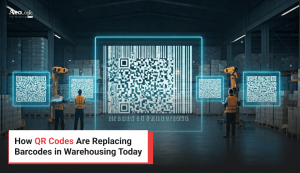RFID technology is a hot topic these days, in part due to the fact that it’s very secure, which gives you peace of mind that your inventory is being tracked securely. RFID technologies are becoming a more and more popular way to track inventory in warehouses. They can help you improve efficiency, decrease theft, and increase profitability. This article will explore the RFID solutions for inventory tracking in your warehouse.
RFID solutions for inventory tracking in your warehouse are essential for businesses of all types. If you want to gain a competitive edge, then implementing RFID solutions could transform your business.
So, with a little planning and foresight, you can use radio frequency identification (RFID) solutions to track your inventory and help you optimize your business. There are many warehouse managers that are using it for their inventory tracking facility. Lets begin!
Table of contents
- Introduction
- What is an RFID tag?
- What is Inventory Management with RFID?
- How Does an RFID Solution Work in Inventory Tracking?
- How Does an RFID Solution Increase Efficiency in your Warehouse?
- Benefits of Using RFID Tags for Tracking Inventory in Your Warehouse
- How to Integrate RFID with your Current Warehouse Management System?
- Conclusion
- FAQ
Introduction
An RFID tag is a small electronic device that can be attached to an item to help you track it. They’re useful for inventory management because they allow you to track items without needing to carry them around. You can use an RFID solution in the warehouse, or even outside of the warehouse if you want.
Also Read: Why Is CRM Software a Game-changer When It Comes to Delivering Better Customer Experiences?
What is an RFID tag?
RFID stands for radio frequency identification, and it’s basically a way of tagging items so that they can be tracked through a system.
It is the wireless tracking of objects, people, and animals. RFID tags are made of a semiconductor material that has been through a process called “sintering” in which it is pressed into a rigid, waterproof plastic. The tag is then coated with a reflective layer that enables it to be read by an antenna on the reader.
RFID tags are small, computer-readable transponders that contain a unique serial number. They can be read by an RFID scanner, which is a handheld device that detects the number on the tag and records the information in a database.
These tags are wireless devices that can be attached to objects, animals, or people. RFID scanners can read these tags and tell the tag’s owner information about it. In the case of inventory tracking, this includes things like location, weight, and dimensions.
Also Read: 10 Ways to Use Artificial Intelligence to Improve Business Processes
What is Inventory Management with RFID?
RFID-enabled inventory management is a new way of tracking and managing your goods that has become more popular in the last few years. It’s particularly useful for businesses that have a lot of products but need to keep track of them efficiently.
RFID tagging has become an essential part of inventory management. It helps to ensure that items are accurately tracked and that the inventory is kept up-to-date. This is especially important for companies that sell products online, as it helps them to avoid expensive mistakes such as overstocking and understocking.
How Does an RFID Solution Work in Inventory Tracking?
RFID tags are small devices containing electronics and a battery, which are designed to be read by radio waves. They have a unique electrical signature that identifies them as being part of an inventory system. The tags are usually about the size of a grain of rice with a protruding antenna that allows them to be read from up to 30 feet away. The main purpose of using RFID tags is so that you can read the information stored on them and use it to track inventory items throughout the warehouse or retail store.
Also Read: The Role & Benefits of ERP in Supply Chain Management
RFID Solutions for Warehouse Management
The key to putting an RFID system to excellent use in your warehouse is to first figure out where the biggest problems are and then choose the most cost-effective way to fix them. Examples of common uses are:
- Entrance management
- Outbound management
- Pull and choose
- Inventories and storage
- Transportable Returned Items (RTIs)
Also Read: Information Technology to Support the New Values of the EV
Aeologic’s RFID solutions can help you save money on your inventory.
How Does an RFID Solution Increase Efficiency in your Warehouse?
RFID solutions for inventory tracking are a great way to increase efficiency in your warehouse.
An RFID tag is a small, wireless device that stores data about something or someone. It’s like a miniature computer that can be attached to objects and animals so we can keep track of them without having to manage physical inventory. It’s easy to use, lightweight, and low maintenance, just plug it into the wall, and you’ll be ready to use it!
RFID solutions for inventory tracking work by putting RFID tags on items as they’re being picked up from storage. This allows us to find out where each item is located at any given time. When we hear an alarm go off in our warehouse (for example), we pull up the information stored on each tag via our software which tells us exactly where each item is located right now.
Read: The Role of AI in Education And Learning: Just Promises Or Revolution
Benefits of Using RFID Tags for Tracking Inventory in Your Warehouse
The benefits of using RFID tags for tracking inventory in a warehouse include:
- Reduced Costs: The cost of using RFID technology is much less than traditional methods like barcodes and scanners, which can be costly and require some training on how they work.
- Faster Inventory Verification: With RFID tags, you only need one person instead of multiple people who might not be able to see the tag at all times. This means faster inventory verification times and fewer errors when it comes time for someone to pull an item’s status report.
- Better Customer Service: One of the biggest benefits of using RFID tags is that it makes it easier for customers or potential buyers to find out what they want without having to ask questions first! They’ll know exactly where the item is when it was purchased and how much it costs. This helps you avoid a lot of misunderstandings from customers who may not know what they want or need to buy until they see it!
- Less Wear and Tear: Another benefit, RFID tags are made from durable materials that can last for years without any damage if you care for them properly. RFID tags are also waterproof and can withstand high temperatures, so they won’t be damaged in the washing machine or if you leave them out in the sun. This makes them perfect for people who use their clothes often and want to make sure they last!
- Better Tracking: RFID tags are a small chip that can store information about your clothes. This makes it easy to keep track of what you have in stock and where each item is located. When you are trying to find something quickly, this can be invaluable!
Overall, RFID inventory management systems offer numerous benefits over traditional barcode-based and manual systems. This makes them the perfect choice for businesses that want to improve the way they manage their inventory and warehouses.
If you are looking for a better way to track inventory in your warehouse, consider integrating RFID technology.
How to Integrate RFID with your Current Warehouse Management System?
RFID is a technology that allows you to track inventory in your warehouse. RFID can help you manage your product inventory, reduce theft and shrinkage, and improve efficiency.
You’ve got a warehouse full of inventory that you want to track in real time. You want to know where every item is at any given moment, and you want to be able to track how much stock you have in each aisle. But how do you make sure that your inventory system is connected to RFID technology?
The first thing you need to do is choose an RFID solution that can handle your needs. You might not need an integrated system right away—you might only need something simple for the beginning stages of integrating RFID into your current warehouse management system (WMS). If this is the case, we recommend choosing a WMS that has built-in support for RFID. This will allow you to start using it right away without having to worry about buying additional hardware or software.
Once you have chosen an RFID solution (or if you already have one), then it’s time for some research! There are many different types of RFID systems available, so be sure to look at all of them before making any decisions about which one would be best for your situation.
The key thing here is understanding what kind of data will be collected by each type of system and how you can use that data to make better decisions about your warehouse management. You should also look at the cost of each system, as well as how easy it is to install and maintain. Once you have done this research, then you will be ready to choose an RFID solution for your warehouse!
Conclusion
The final takeaway from all this is that you should use RFID tags for your inventory tracking as much as possible. Aside from the cost-saving benefits, it will make life a whole lot easier in the long run. You could probably hack together a solution using barcode scanning and other technologies, but RFID really is the way to go if you want something efficient and worry-free.
The addition of RFID technology can help you to tackle the issues that plague warehouse management, improving your inventory efficiency. It’s an ideal choice for medium and large-sized facilities or warehouses with unique needs.
You may quickly expand your company using the RFID Solution. Ask for a free trial of Aeologic’s software and see how RFID, the best option, can help your company expand.
Aeologic is a great place to start!
Also read: Trends in Sensor Technology and the Electric Vehicle Industry
FAQ’s
How does the RFID system work in the warehouse to keep track of packages?
Through an electromagnetic signal, the RFID tag sends information about the package or item to a central database. As an item moves through the warehouse system, the warehouse management system looks at the data and updates it.
How can RFID assist inventory tracking?
A company can identify specific goods and parts using radio frequency identification (RFID) and trace them from the point of manufacturing to the point of sale. What are some challenges with using RFID?
- Materials like metal & liquid can impact signal.
- Not always as reliable or accurate as barcode scanners.
- Cost of RFID readers are 10 times more expensive than barcode readers.
- Implementation can be hard and take a long time.
Related Blogs:
- How AI/ML Can Change the Public Transportation Industry
- Transforming Business With Digital Technology in the Oil Palm Industry in India
- Importance of Digital Asset Management in the Retail Industry
- How AI is Transforming the Agriculture Industry
- 10 Ways to Use Artificial Intelligence to Improve Business Processes
- The Future of IoT Technology in Convenience Stores
- Building Manufacturing Resilience Through AI and ML







